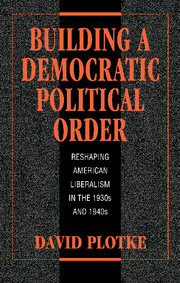Book contents
- Frontmatter
- Contents
- Preface
- Introduction: The Democratic order as a political project
- 1 When does politics change?
- 2 Creating political orders: the logic of the Democratic experience
- 3 Democratic opportunities in the crises of the 1930s
- 4 Passing the Wagner Act and building a new Democratic state
- 5 Party and movements in the Democratic upsurge, 1935–7
- 6 Progressive liberalism as pragmatic common sense
- 7 Surprising years: electing Truman and sustaining the Democratic order, 1947–9
- 8 Passing Taft-Hartley: what the losers won (and what the winners lost)
- 9 New political fronts? growth and civil rights in the 1940s
- 10 Democratic anti-Communism and the Cold War
- 11 From Truman to Kennedy: the reach and limits of Democratic power
- 12 Was the Democratic order democratic?
- Index
11 - From Truman to Kennedy: the reach and limits of Democratic power
Published online by Cambridge University Press: 17 September 2009
- Frontmatter
- Contents
- Preface
- Introduction: The Democratic order as a political project
- 1 When does politics change?
- 2 Creating political orders: the logic of the Democratic experience
- 3 Democratic opportunities in the crises of the 1930s
- 4 Passing the Wagner Act and building a new Democratic state
- 5 Party and movements in the Democratic upsurge, 1935–7
- 6 Progressive liberalism as pragmatic common sense
- 7 Surprising years: electing Truman and sustaining the Democratic order, 1947–9
- 8 Passing Taft-Hartley: what the losers won (and what the winners lost)
- 9 New political fronts? growth and civil rights in the 1940s
- 10 Democratic anti-Communism and the Cold War
- 11 From Truman to Kennedy: the reach and limits of Democratic power
- 12 Was the Democratic order democratic?
- Index
Summary
In 1947–9 the Democratic order was maintained in the face of serious challenges. Taft-Hartley, the Cold War and domestic anti-Communism, and sustained economic growth did not mean a basic political rupture. A Democratic regime persisted primarily due to the strength of the political forces built in the 1930s: The Democratic bloc was institutionalized, while Democratic discourses defined political common sense. This surprised many who expected Democratic power to perish with Roosevelt and who presumed Truman would be forced out of office in 1948.
What would a real break have looked like? In labor relations, a decisive anti-Democratic turn would have expanded Taft-Hartley to include additional severe provisions and led to other laws enabling employers to undermine independent unions and block new unionization. Charges of Democratic statism would have stigmatized the social welfare provision of the Democratic state, rolling back some of the New Deal and altogether ruling out new reforms. Liberal Keynesian policies would have been rejected in favor of reliance on market forces. Such policies were favored by significant currents in American politics. They did not occur because Democratic forces – in the state, party, and movements – had the capacity to prevent them. In 1947–9, each point of the core Democratic triangle – the state, interest groups, and the party – made a positive contribution to sustaining the Democratic order, while the primacy of the state and the presidency increased.
- Type
- Chapter
- Information
- Building a Democratic Political OrderReshaping American Liberalism in the 1930s and 1940s, pp. 336 - 358Publisher: Cambridge University PressPrint publication year: 1996



